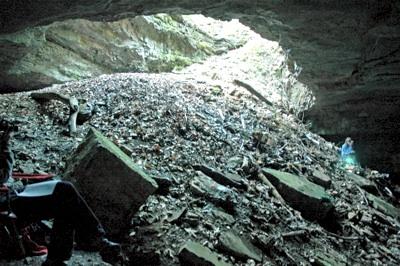Editor's note: National parks attract more than just visitors. At Mammoth Cave National Park, a handful of college interns spent their summer in the park doing research. The following story, by the park's public affairs officer, Vickie Carson, takes a look at two interns who counted bats in the park.
While most visitors to Mammoth Cave National Park take a cave tour or two and then head on their way, Marissa Maldonado and Samantha Sterman spent their summer counting bats at the park.
Outfitted with night-vision goggles and infra-red LEDs, the two spent June, July, and August at Mammoth Cave counting bats.
“We have some unusual work for students who are conservation-minded and want to spend their summer outdoors,” said Eddie Wells, the park’s volunteer coordinator. “We hosted 16 interns this summer, and sent them out to test water quality in the backcountry, inventory protected plants, combat exotic plants, as well as monitor the park’s bat populations.”
Assigned to the night shift, Ms. Maldonado, from Midlothian, Virginia, and Ms. Sterman, from New York City, traveled all over the 53,000-acre park in search of bats. They positioned themselves at known bat roosts (cave entrances, buildings, and trees) at dusk and waited for bats to exit. Using infrared lights and night-vision goggles, they counted each bat and recorded its species, if known.
Some nights the two gathered data using a recording-bat-detector on loan to the park from the U.S. Fish and Wildlife Service. With a microphone attached to the roof of a truck, they drove an established route at 20 mph. The detector recorded ultrasonic calls (echolocation) that bats make when traveling or feeding in low light conditions.
“The information we gain from this study will be shared with USFWS and the Kentucky Department of Fish and Wildlife Resources,” said Mammoth Cave Superintendent Patrick Reed. “With white-nose syndrome on our doorstep, these are critical data that we haven’t previously collected--at least not on this scale.”
White-nose syndrome is a fungal disease that has killed approximately 1 million bats in the eastern United States since 2006. In caves where WNS is present, up to 95 percent of the bats have died during hibernation. The disease has not been discovered in Kentucky to date.
Ms. Maldonado graduated this year from Virginia Tech with a bachelor’s degree in biology. Ms. Sterman will begin her second year at Oberlin College this fall.
The summer interns at Mammoth Cave were hired through the Student Conservation Association (SCA); the park received special funding through the National Park Service Youth Intern Program.
“SCA provides us with skilled, enthusiastic workers,” said Dr. Rick Toomey, director of the Mammoth Cave International Center for Science and Learning, who coordinates park research projects. “The students get experience working in land management by helping the park with significant environmental issues. In the case of the bat monitoring program, the emergence counts and acoustic transects will provide base-line data critical to park management. The information will also be fed into a national study of summer bat activity.”




Add comment